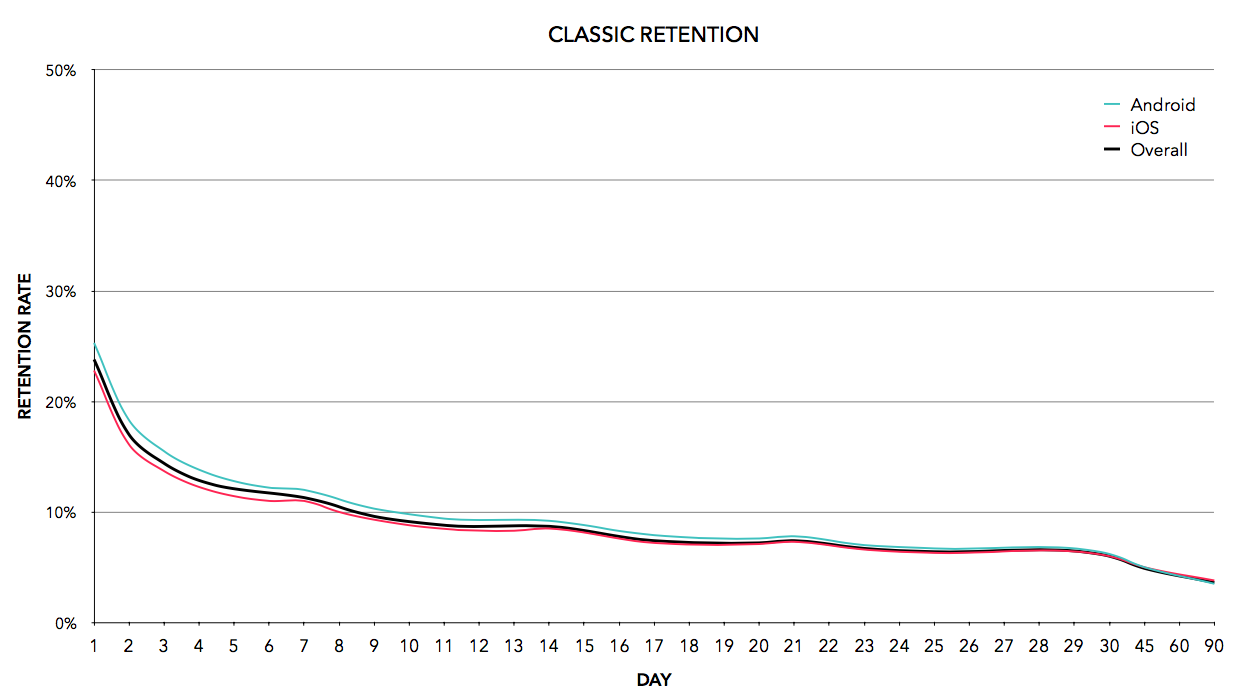[caption id="attachment_137629" align="aligncenter" width="3600"]

App retention[/caption] Creating an app is one thing, but keeping users engaged is a completely different beast. While few developers will ever enjoy the massive success of
Pokemon Go, new data suggests that holding onto users may be harder than we think. According to marketing service
Appboy, the first day of use is typically the best, in terms of user activity. But while launch-day initiatives such as media coverage may help push an app to home-screens across the world, the service reports that less than 25 percent of new users return after that first day. And the long-term outlook isn’t much rosier: the study indicates that, 90 days after launch, only about 5 percent of users stick around (on average). The downward trend is interesting, too. After a sharp decline the first week, retention trails off fairly steadily over the course of 90 days. Between 30 and 90 days, user numbers reduce by about 50 percent. The decline is a touch sharper between day seven and the end of an app’s first month.

Those numbers represent a macro view of app user retention, but there were some granular observations, as well. Food and beverage apps typically had half the first-day mean retention figures, but spiked slightly every seven days or so. While Appboy doesn’t identify a trend, it could be users accessing the app for a night out (such as a reservations app, or possibly even food delivery; you need to do something on a weekend, after all). As you might expect, games see a higher retention rate on average – about 40 percent after day one – but have the same identifiable downward trend. At the 90-day mark, games fare only slightly better than the average app for retention. Platforms don’t matter much, either. Though Android retention is typically slightly higher than iOS, the difference is not appreciable. After 30 and 90 days, the two platforms homogenize with regard to retention numbers. Still, the data shows how users are choosing to access the platforms. Apple iOS had better social and messaging retention rates, and a much stronger hold on finance app users; it also outperforms Android with regard to medical apps, no doubt aided by Apple Watch, which emphasizes fitness features. On the other hand, Android has slightly better retail app user retention, and fared better with gaming apps. It also schools iOS when it comes to utility apps, something we can likely attribute to Nest (an ecosystem of Internet of Things devices) and the popular IFTTT platform popular amongst Android users. Appboy’s findings are cautionary, but also interesting. It’s a good measure of actual user retention, and useful information for developers considering a new service. If an app were to rely on servers, you’d at least know how to budget for such a service over time, or what long-term revenue for in-app purchases might look like.
 App retention[/caption] Creating an app is one thing, but keeping users engaged is a completely different beast. While few developers will ever enjoy the massive success of Pokemon Go, new data suggests that holding onto users may be harder than we think. According to marketing service Appboy, the first day of use is typically the best, in terms of user activity. But while launch-day initiatives such as media coverage may help push an app to home-screens across the world, the service reports that less than 25 percent of new users return after that first day. And the long-term outlook isn’t much rosier: the study indicates that, 90 days after launch, only about 5 percent of users stick around (on average). The downward trend is interesting, too. After a sharp decline the first week, retention trails off fairly steadily over the course of 90 days. Between 30 and 90 days, user numbers reduce by about 50 percent. The decline is a touch sharper between day seven and the end of an app’s first month.
App retention[/caption] Creating an app is one thing, but keeping users engaged is a completely different beast. While few developers will ever enjoy the massive success of Pokemon Go, new data suggests that holding onto users may be harder than we think. According to marketing service Appboy, the first day of use is typically the best, in terms of user activity. But while launch-day initiatives such as media coverage may help push an app to home-screens across the world, the service reports that less than 25 percent of new users return after that first day. And the long-term outlook isn’t much rosier: the study indicates that, 90 days after launch, only about 5 percent of users stick around (on average). The downward trend is interesting, too. After a sharp decline the first week, retention trails off fairly steadily over the course of 90 days. Between 30 and 90 days, user numbers reduce by about 50 percent. The decline is a touch sharper between day seven and the end of an app’s first month.  Those numbers represent a macro view of app user retention, but there were some granular observations, as well. Food and beverage apps typically had half the first-day mean retention figures, but spiked slightly every seven days or so. While Appboy doesn’t identify a trend, it could be users accessing the app for a night out (such as a reservations app, or possibly even food delivery; you need to do something on a weekend, after all). As you might expect, games see a higher retention rate on average – about 40 percent after day one – but have the same identifiable downward trend. At the 90-day mark, games fare only slightly better than the average app for retention. Platforms don’t matter much, either. Though Android retention is typically slightly higher than iOS, the difference is not appreciable. After 30 and 90 days, the two platforms homogenize with regard to retention numbers. Still, the data shows how users are choosing to access the platforms. Apple iOS had better social and messaging retention rates, and a much stronger hold on finance app users; it also outperforms Android with regard to medical apps, no doubt aided by Apple Watch, which emphasizes fitness features. On the other hand, Android has slightly better retail app user retention, and fared better with gaming apps. It also schools iOS when it comes to utility apps, something we can likely attribute to Nest (an ecosystem of Internet of Things devices) and the popular IFTTT platform popular amongst Android users. Appboy’s findings are cautionary, but also interesting. It’s a good measure of actual user retention, and useful information for developers considering a new service. If an app were to rely on servers, you’d at least know how to budget for such a service over time, or what long-term revenue for in-app purchases might look like.
Those numbers represent a macro view of app user retention, but there were some granular observations, as well. Food and beverage apps typically had half the first-day mean retention figures, but spiked slightly every seven days or so. While Appboy doesn’t identify a trend, it could be users accessing the app for a night out (such as a reservations app, or possibly even food delivery; you need to do something on a weekend, after all). As you might expect, games see a higher retention rate on average – about 40 percent after day one – but have the same identifiable downward trend. At the 90-day mark, games fare only slightly better than the average app for retention. Platforms don’t matter much, either. Though Android retention is typically slightly higher than iOS, the difference is not appreciable. After 30 and 90 days, the two platforms homogenize with regard to retention numbers. Still, the data shows how users are choosing to access the platforms. Apple iOS had better social and messaging retention rates, and a much stronger hold on finance app users; it also outperforms Android with regard to medical apps, no doubt aided by Apple Watch, which emphasizes fitness features. On the other hand, Android has slightly better retail app user retention, and fared better with gaming apps. It also schools iOS when it comes to utility apps, something we can likely attribute to Nest (an ecosystem of Internet of Things devices) and the popular IFTTT platform popular amongst Android users. Appboy’s findings are cautionary, but also interesting. It’s a good measure of actual user retention, and useful information for developers considering a new service. If an app were to rely on servers, you’d at least know how to budget for such a service over time, or what long-term revenue for in-app purchases might look like. 


